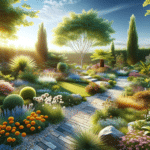Introduction to Native Landscaping
Native landscaping is becoming a popular choice among homeowners who wish to create beautiful, sustainable, and low-maintenance gardens. By utilizing plants that are native to the local environment, these gardens are not only easier to maintain but also beneficial to the ecosystem. Native plants are adapted to the local climate and soil conditions, requiring less water, fertilizer, and pesticides. This approach not only saves time and resources but also supports local wildlife, including pollinators like bees and butterflies. In this article, we will explore the principles of native landscaping, the benefits of drought-resistant plants, and ideas for creating a low-maintenance garden.
Designing with Native Plants
Creating a garden with native plants involves understanding the local flora and how it interacts with the environment. Native plants are naturally equipped to thrive in the local climate, making them a resilient choice for landscaping. When designing with native plants, consider the following:
- Site Analysis: Assess the conditions of your garden, such as sun exposure, soil type, and moisture levels, to choose plants that will thrive.
- Plant Selection: Choose a variety of native plants that provide seasonal interest, including flowers, shrubs, and trees that bloom at different times of the year.
- Layering: Use a mix of ground covers, mid-level plants, and taller trees or shrubs to create depth and visual interest.
By incorporating these elements, you can design a garden that is not only visually appealing but also resilient and supportive of local biodiversity.
Low-Maintenance Garden Ideas
For those who prefer a garden that requires minimal upkeep, low-maintenance landscaping is an ideal solution. The key is to design with simplicity and sustainability in mind. Here are some ideas to consider:
- Perennials Over Annuals: Opt for perennial plants that return year after year, reducing the need for replanting.
- Mulching: Use mulch to suppress weeds, retain moisture, and add nutrients back into the soil.
- Efficient Irrigation: Install a drip irrigation system to deliver water directly to the roots, minimizing waste and ensuring plants receive adequate hydration.
By implementing these strategies, you can enjoy a lush garden with less effort, allowing you to spend more time enjoying your outdoor space rather than maintaining it.
Drought-Resistant Plants for Sustainable Gardens
In regions prone to dry spells, incorporating drought-resistant plants into your garden is a smart choice. These plants are adapted to survive with minimal water, making them ideal for sustainable landscaping. Some popular drought-resistant plants include:
- Succulents: Known for their water-storing leaves, succulents are both attractive and low-maintenance.
- Lavender: With its fragrant blooms and ability to thrive in dry conditions, lavender is a favorite among gardeners.
- Agave: This striking plant is not only drought-tolerant but also adds architectural interest to the garden.
By selecting drought-resistant plants, you can create a garden that remains vibrant and healthy even during times of water scarcity, contributing to environmental conservation efforts.
Conclusion: Embracing Sustainable Landscaping
Native landscaping, combined with low-maintenance and drought-resistant plant choices, offers a practical and environmentally friendly approach to gardening. By selecting plants that are well-suited to local conditions, homeowners can create stunning outdoor spaces that require less water and maintenance, while supporting local ecosystems. Whether you’re a seasoned gardener or a novice, embracing these principles can lead to a more sustainable and enjoyable gardening experience. As more people recognize the importance of sustainable practices, native landscaping stands out as a compelling option for creating beautiful, resilient gardens.


